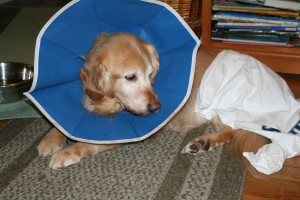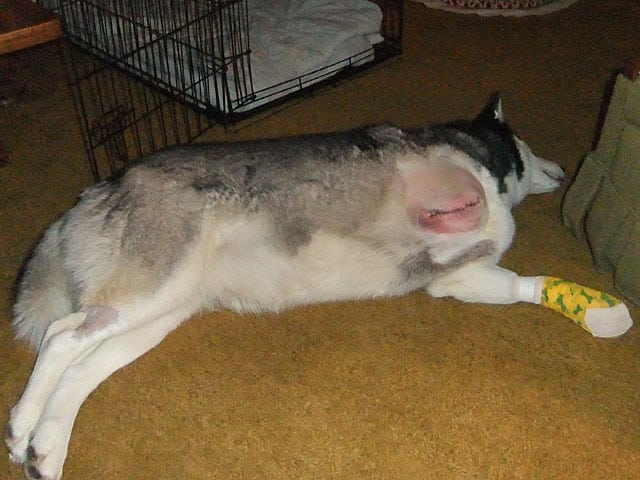Caring for a Three Legged Dog or Cat
Tripawds is your home to learn how to care for a three legged dog or cat, with answers about dog leg amputation, and cat amputation recovery from many years of member experiences.
Join The Tripawds Community
Learn how to help three legged dogs and cats in the forums below. Browse and search as a guest or register for free and get full member benefits:
Instant post approval.
Private messages to members.
Subscribe to favorite topics.
Live Chat and much more!
Amputation.
 The word makes dog pawents nervous, and it's easy to understand why.
The word makes dog pawents nervous, and it's easy to understand why.
There's the once-unfathomable idea of watching your dog become a "tripod." And then there are the possible complications that can result from this procedure.
Like all surgeries, amputation has risks. They can range from bruising and swelling to fatal blood clots during surgery.
But as other Tripawd pawrents have reported, amputation surgery side effects are few and far between. According to the American College of Veterinary Surgeons:
“the complication rate is very low. The most common complications , which occur in less than 5% of cases, are wound infection, wound breakdown, and accumulation of fluid underneath the surgical site (i.e., seroma formation).”
The first step you can take toward recuing your dog's risk of post-amputation surgery problems is by learning how to find the best vet for amputation surgery.
Tripawds Doc Discusses Post-Amputation Side Effects
Tripawds recently talked about amputation surgery risks with one of our biggest supporters, Dr. Pam Wiltzius of River Road Animal Hospital in Puyallup, Washington. Dr. Wiltzius isn't just a vet who works with dogs facing amputation surgery, she also has firsthand experience with amputation because her beloved dog Tazzie went through the process herself after being diagnosed with bone cancer.
We asked Dr. Wiltzius if she could tell us about the most common amputation surgery risks. Here's what she had to say:
[youtube][/youtube]
A Primer on Post-Amputation Surgery Side Effects
Seromas
A seroma is an abnormal accumulation of fluid that occurs after amputation surgery. After a leg is removed, body fluids can build up at the area of least possible resistance, the surgical site. Some veterinarians will insert a drainage tube prior to surgery to encourage fluid drainage, some won't. Before surgery, ask your vet what their preference is.
 If you notice a large pocket of fluid building up around the incision, accompanied by some dripping, your dog may have a seroma
. Seromas can happen after any invasive procedure but are most common with amputation surgeries. Although seromas look terrible, usually they are harmless and can be often be resolved with a pressure bandage and/or draining in the office.
If you notice a large pocket of fluid building up around the incision, accompanied by some dripping, your dog may have a seroma
. Seromas can happen after any invasive procedure but are most common with amputation surgeries. Although seromas look terrible, usually they are harmless and can be often be resolved with a pressure bandage and/or draining in the office.
When to See Your Vet
If a seroma is present, you'll see a clear to light pink fluid dripping from the incision area. The fluid is clear, without any cloudiness.
The best way to tell if your dog needs an in-office vet visit is to watch how quickly the fluid is dripping. If the fluid is dripping faster than one drop per second, call your vet. Before calling, take note of the color and consistency. If the fluid is viscous or appears as dark to purple in color, your dog may have an infection or an untied blood vessel and your vet should know about this. When infection is present, the bacteria can destroy tissues around the sutures and cause the sutures to come undone. In a worst case scenario, a second surgery will be required to eliminate the diseased tissue and close up the area.
How to Prevent Seromas
Seromas are often linked to excessive activity immediately after surgery. One of the best ways to prevent them is to keep your dog calm, quiet and confined for a few days. Dr Wiltzius also advises using a pressure bandage after surgery.
If there is any sign of a seroma , call your veterinarian immediately.
Phantom Limb Pain
Phantom limb pain is another common side effect after amputation surgery. Again, it's a side effect that can be controlled, and even prevented.
Phantom pain happens when a severed nerve “thinks” that the limb is still attached to the body. The nerve is trying to control a limb that doesn't exist.
Your dog may have phantom pain if she:
- Constantly looks behind her to see if the leg is there
- Attempts to move the area where the limb was
- Randomly cries out with loud, sharp shrieks
- Has light muscle twitching in the incision area
- Shakes or pants (which could also indicate general post-op pain)
Phantom pain is a normal complication and many amputee dogs get it. Although time is the best thing that can help the severed nerve to heal, you can take steps to alleviate this pain.
- Tripawd Calpurnia's Mom posted some great phantom limb pain tips here.
- If you suspect your dog has phantom pain , try a hot/cold pack which can help with generalized inflammation and swelling. We like Bella's Pain Relief Pack because it was made just for a dog's anatomy.
- You can also ask your vet about the drug Gabapentin.
Gabapentin is a human drug that is also used in dogs. The National Institute of Health says:
“Gabapentin is used to help control certain types of seizures in patients who have epilepsy. Gabapentin is also used to relieve the pain of postherpetic neuralgia (PHN; the burning, stabbing pain or aches that may last for months or years after an attack of shingles). Gabapentin is in a class of medications called anticonvulsants. Gabapentin treats seizures by decreasing abnormal excitement in the brain. Gabapentin relieves the pain of PHN by changing the way the body senses pain.”
Many human and animal medical studies have shown that if you start Gabapentin just one day before amputation and continue for a week afterward, it can eliminate or reduce phantom limb pain. Even if your dog doesn't have Gabapentin prior to surgery, it can still be used post-op. Most dogs take two to 3 times daily for best results.
Gabapentin is a newer pain relief option in veterinary medicine, and many vets are still unfamiliar with it. If yours doesn't know about this important drug, ask them to consult with a veterinary pain management specialist from the International Veterinary Academy of Pain Management.
Post-Surgery Blood Clot Risk
Blood clots are the least common post-amputation surgery side effect and very rare. Unfortunately we have seen them happen here at Tripawds, so it's important to be aware of the risk.
According to the Merck Veterinary Manual:
“A thrombus is an aggregation of blood factors that may form when the blood flow in the arteries or veins is impeded. It frequently causes vascular obstruction at its site of origin. The thrombus can be classified based on its location and the syndrome it produces (eg, venous thrombosis in large animals associated with prolonged venous catheterization, pulmonary arterial thrombosis associated with heartworm disease in dogs). All or part of a thrombus may break off and be carried through the bloodstream as an embolus that lodges distally at a point of narrowing. Embolization can also occur when foreign material (eg, bacteria, air, fat, catheter piece) is carried into the bloodstream.
Thrombi and emboli can be septic or nonseptic. Poor injection or catheterization techniques and inferior catheter material can all result in vascular thrombosis. However, life-threatening vascular thrombosis is more commonly encountered in patients with underlying disease states that result in coagulopathies, such as systemic inflammation, or endotoxemia. . . .
If left untreated or uncontrolled, these hypercoagulable conditions can result in hemorrhagic diathesis and/or disseminated intravascular coagulation (DIC), a life-threatening disorder of hemostasis with deposition of microthrombi with concurrent hemorrhage.”
Unfortunately blood clots can only be diagnosed when a MRI is performed, and many times they happen before anything can be done about them. Before surgery, talk to your vet about your dog's risk of blood clots during and after surgery.
Many thanks to Dr. Wiltzius for her pawesome perspective on canine amputation and bone cancer.
Read more tips about canine amputation from Dr. Wiltzius:
Tripawds Founders Jim and Rene
tripawds.com | tripawds.org | bemoredog.net | triday.pet
1 Guest(s)

 Register
Register Log In
Log In Members
Members

 Read the original blog post
Read the original blog post Add Reply
Add Reply Add Topic
Add Topic Offline
Offline








